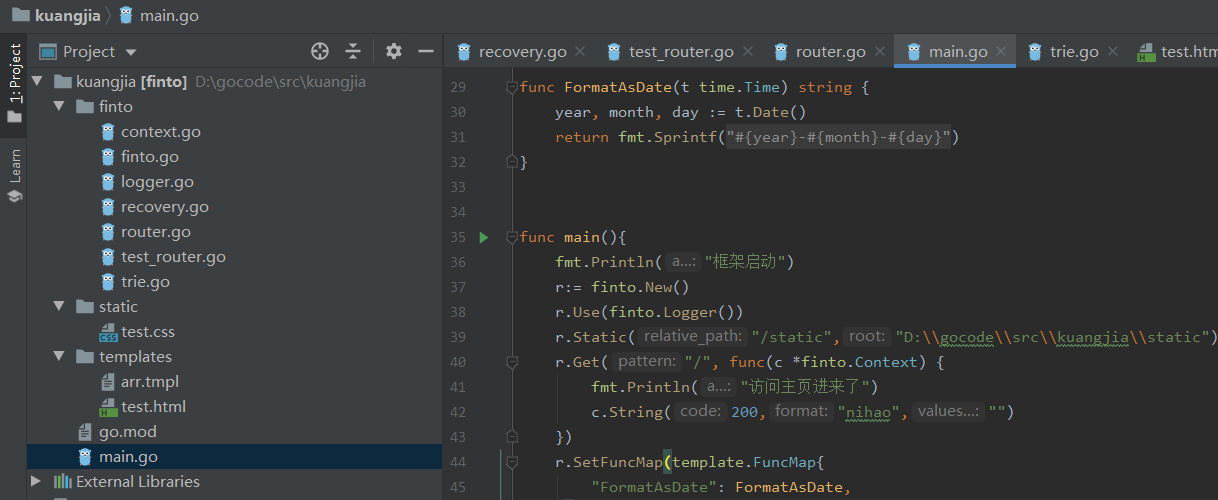第五章-(模板And静态文件)
网页的三剑客,JavaScript、CSS 和 HTML。要做到服务端渲染,第一步便是要支持 JS、CSS 等静态文件。还记得我们之前设计动态路由的时候,支持通配符*匹配多级子路径。比如路由规则/assets/*filepath,可以匹配/assets/开头的所有的地址。例如/assets/js/geektutu.js,匹配后,参数filepath就赋值为js/geektutu.js。
那如果我么将所有的静态文件放在/usr/web目录下,那么filepath的值即是该目录下文件的相对地址。映射到真实的文件后,将文件返回,静态服务器就实现了。
找到文件后,如何返回这一步,net/http库已经实现了。因此,gee 框架要做的,仅仅是解析请求的地址,映射到服务器上文件的真实地址,交给http.FileServer处理就好了。
在finto.go文件中添加静态文件处理函数
// create static handler
func (group *RouterGroup) createStaticHandler(relativePath string, fs http.FileSystem) HandlerFunc {
absolutePath := path.Join(group.prefix, relativePath)
fileServer := http.StripPrefix(absolutePath, http.FileServer(fs))
return func(c *Context) {
file := c.Param("filepath")
// Check if file exists and/or if we have permission to access it
if _, err := fs.Open(file); err != nil {
c.Status(http.StatusNotFound)
return
}
fileServer.ServeHTTP(c.Writer, c.Req)
}
}
// serve static files
func (group *RouterGroup) Static(relativePath string, root string) {
handler := group.createStaticHandler(relativePath, http.Dir(root))
urlPattern := path.Join(relativePath, "/*filepath")
// Register GET handlers
group.GET(urlPattern, handler)
}
我们添加了两个方法,其中Static方法是暴露给用户的,在主函数中的使用案例:
func main(){
fmt.Println("框架启动")
r:= finto.New()
r.Use(finto.Logger())
r.Static("/static","D:\\gocode\\src\\kuangjia\\static")
r.Get("/", func(c *finto.Context) {
fmt.Println("访问主页进来了")
c.String(200,"nihao","")
})
HTML 模板渲染
Go语言内置了text/template和html/template2个模板标准库,其中html/template为 HTML 提供了较为完整的支持。包括普通变量渲染、列表渲染、对象渲染等。gee 框架的模板渲染直接使用了html/template提供的能力。
Engine struct {
*RouterGroup
router *router
groups []*RouterGroup // store all groups
htmlTemplates *template.Template // for html render
funcMap template.FuncMap // for html render
}
func (engine *Engine) SetFuncMap(funcMap template.FuncMap) {
engine.funcMap = funcMap
}
func (engine *Engine) LoadHTMLGlob(pattern string) {
engine.htmlTemplates = template.Must(template.New("").Funcs(engine.funcMap).ParseGlob(pattern))
}
首先为 Engine 示例添加了 *template.Template 和 template.FuncMap对象,前者将所有的模板加载进内存,后者是所有的自定义模板渲染函数。
另外,给用户分别提供了设置自定义渲染函数funcMap和加载模板的方法。
接下来,对原来的 (*Context).HTML()方法做了些小修改,使之支持根据模板文件名选择模板进行渲染。
type Context struct {
// ...
// engine pointer
engine *Engine
}
func (c *Context) HTML(code int, name string, data interface{}) {
c.SetHeader("Content-Type", "text/html")
c.Status(code)
if err := c.engine.htmlTemplates.ExecuteTemplate(c.Writer, name, data); err != nil {
c.String(500, err.Error())
}
我们在 Context 中添加了成员变量 engine *Engine,这样就能够通过 Context 访问 Engine 中的 HTML 模板。实例化 Context 时,还需要给 c.engine 赋值。
重写serveHTTP方法:
func (engine *Engine) ServeHTTP(w http.ResponseWriter, req *http.Request) {
// ...
c := newContext(w, req)
c.handlers = middlewares
c.engine = engine
engine.router.handle(c)
}

这是现在整个项目的结构目录

